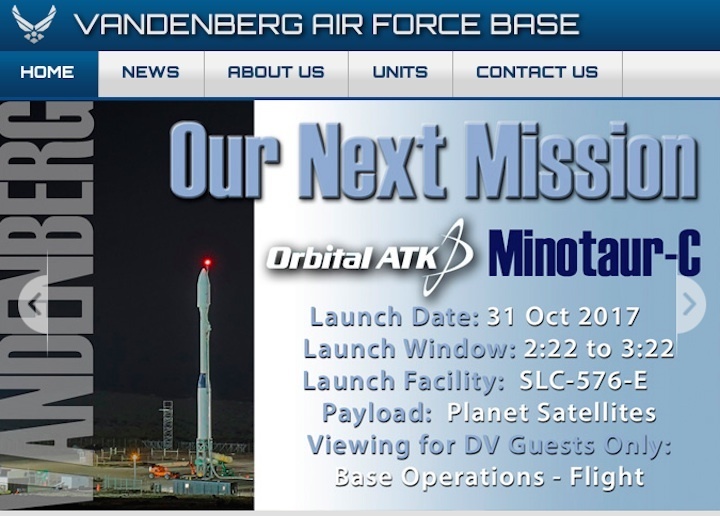30.10.2017
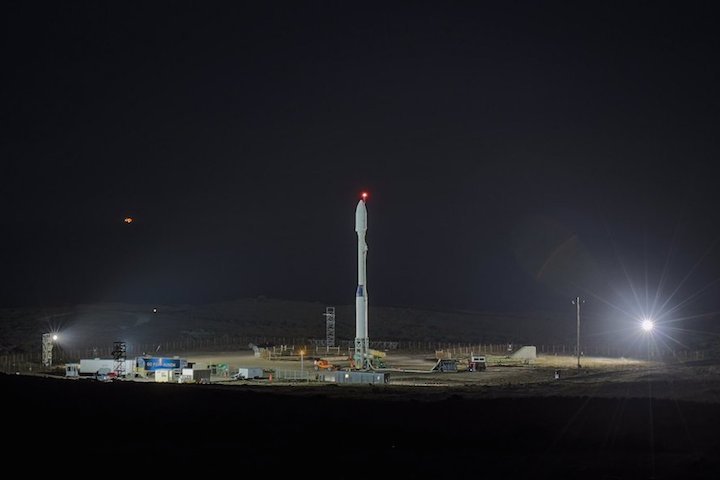
Minotaur-C Scheduled to Launch
Team Vandenberg is scheduled to launch the Skybox imaging satellite aboard the Orbital ATK Minotaur-C rocket from Space Launch Complex 576-E here, Tuesday, Oct. 31, at 2:37 p.m. PDT.
Col. Greg Wood, 30th Space Wing vice commander, is the space launch commander.
"Our unique geographic location makes Vandenberg an ideal place to launch commercial imaging satellites," said Wood. "We are excited to partner with Orbital ATK to make this mission a reality."
For questions about the booster please contact Trina Patterson, Orbital ATK senior manager of communications, at (480) 814-6504.
For questions about the Skybox imaging satellite contact Trevor Hammond, Planet communications director, at (916) 607-0685.
Due to the remoteness of the launch site, the Hawk's Nest on Hwy 1 south of Vandenberg Air Force Base's main gate will not be open.
Quelle: USAF
+++
Mission Update: Minotaur C SkySat Launch

| Launch: | October 31, 2017 2:37 p.m. PDT |
| Launch Site: | SLC-576E, Vandenberg Air Force Base, California |
| Mission Customer: | Planet |
Mission Update
Orbital ATK is set to launch its Minotaur C rocket on October 31, 2017 from Vandenberg Air Force Base, California, on October 31 at approximately 2:37 p.m. PDT. Minotaur C will carry Planet’s SkySat and Dove spacecraft, which will capture medium and high resolution multispectral imagery of Earth at unprecedented scale and frequency for the commercial market. Approximately 12 minutes into flight the ten Planet spacecraft will deploy into their targeted sun synchronous orbit 310 miles (500 kilometers) above the Earth.
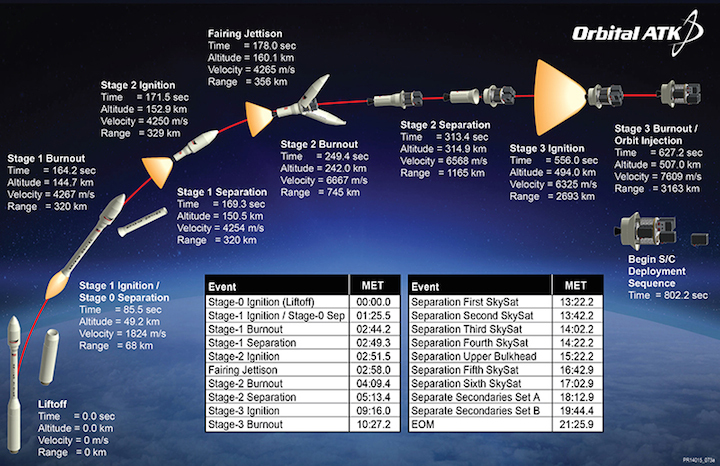
About the Mission
Background on Minotaur C
The Minotaur C space launch vehicle is a variant of the Minotaur product line designed to support U.S. government and commercial customers. Minotaur C employs four Orbital ATK solid rocket motors as its propulsion system, all of which have been flown dozens of times and are thoroughly flight-proven in various combinations on the company's other small space launch vehicles, including Pegasus, Taurus and Minotaur, as well as on the Orbital Boost Vehicle (OBV) long-range missile defense interceptor. It will also incorporate numerous design features that are common with the Minotaur product line, such as the rocket's electrical power system, payload fairing, flight termination system, navigation sensors and RF components.
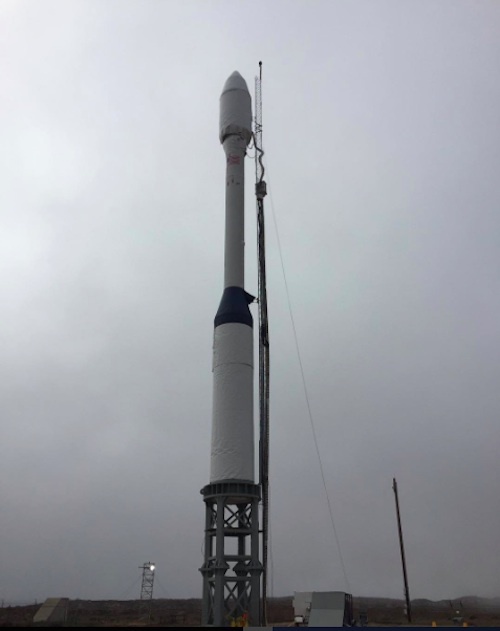
Background on SkySat and Dove Spacecraft
The Dove and SkySat satellites are some of the most capable spacecraft per kilogram ever, capturing medium and high resolution multispectral imagery of Earth at unprecedented scale and frequency. A record-breaking 271 Dove satellites have been successfully deployed and operated in space and today collect more imagery per day than any other commercial provider. The SkySat constellation of 7 SkySats, soon to be 13, is the world’s largest commercial, sub-meter fleet of high-res satellites operating in space. Together, the Dove and SkySat network of remote sensing satellites deliver a global information feed to businesses, governments, and NGOs around the world.
Quelle: Orbital ATK
+++
Update: 31.10.2017
Familiar rocket with new name returns to flight Tuesday
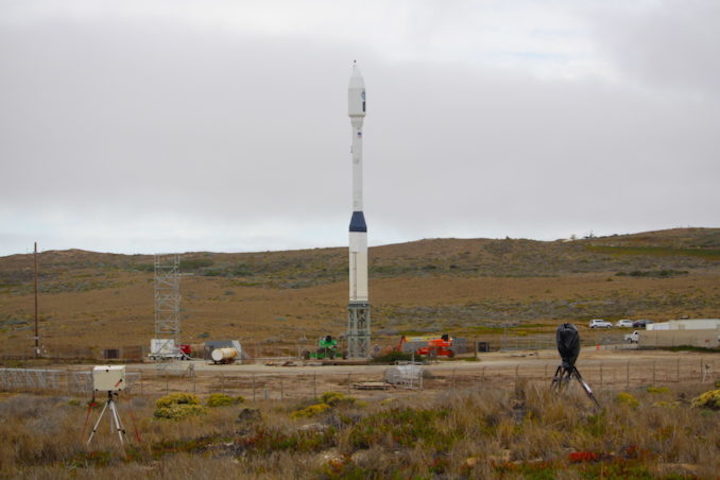
More than six years after back-to-back failures left the Taurus rocket with an uncertain future, a redesigned version of the launcher sporting a new name is set to loft 10 small Earth-imaging satellites into orbit Tuesday from Vandenberg Air Force Base in California.
Now dubbed the Minotaur-C, the four-stage rocket built and operated by Orbital ATK is standing on a launch pad overlooking the rugged Pacific coastline, ready for a 10-minute trip into orbit set to begin at 2:37 p.m. PDT (5:37 p.m. EDT; 2137 GMT) Tuesday, the opening of a 30-minute window.
Ground crews spent the last few weeks assembling the rocket at Space Launch Complex 576-East, an austere launch pad at Vandenberg that was last used in March 2011 on the most recent Taurus flight.
That flight ended in failure, when the Taurus rocket’s payload shroud clung to the vehicle as it climbed into space, preventing NASA’s Glory climate research satellite from reaching orbit. A similar payload fairing failure doomed the previous Taurus flight in 2009, resulting in the loss of another NASA-funded Earth science mission.
The payload fairing was supposed to drop away from the top of the rocket in a clamshell-like fashion a few minutes after liftoff.
The mishaps prompted NASA to switch the launch of the Taurus rocket’s sole remaining mission to another rocket, leaving the light-class launcher without an assured future.
But Orbital ATK, then known as Orbital Sciences, revamped the Taurus program in a bid to keep the launcher active, serving a growing slice of the commercial satellite marketplace that has few good U.S. launch options, at least with rockets that have flown before.
“The elephant in the room is that this is a return-to-flight after two failures,” said John Brunschwyler, Orbital ATK’s Minotaur-C program manager. “We have a significant number of people on the team who were part of those launch campaigns back in 2009 and 2011. Getting back into it, it’s surprisingly fresh and people are very motivated.”
The Minotaur-C rocket will place six SkySat spacecraft into orbit 310 miles (500 kilometers) above Earth to record high-definition video and high-resolution optical still imagery of locales around the world.
Four smaller Dove CubeSats, known as Flock 3m, will also hitch a ride on the rocket, joining the SkySats in a growing fleet of Earth-observing satellites owned by Planet, a San Francisco-based company whose mission is to image the entire globe every day.
Built by Space Systems/Loral, each of the SkySats is about the size of a dorm room refrigerator — measuring 2.5 feet by 2 feet by 2 feet (95 by 60 by 60 centimeters) — and weighs around 242 pounds (110 kilograms). The Doves are built in-house by Planet and are roughly the size of a shoebox.
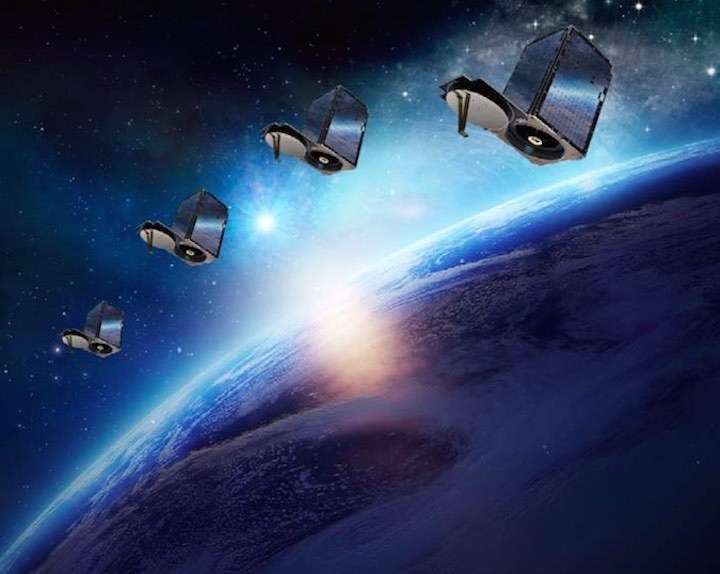
The Minotaur-C rocket launching Tuesday has a different fairing than the Taurus rockets launched in 2009 and 2011. The shroud spans 92 inches (2.3 meters) in diameter, wider than the fairings flown on the last two Taurus rockets.
Investigators probing both fairing failures could not settle on a definite cause, but in both cases, the two halves of the shroud remained on the rocket, weighing it down and keeping it from entering orbit.
The 92-inch fairing design has performed without fault on Orbital ATK’s Minotaur 4 rocket, most recently in August. While similar in design, its separation mechanism is not identical to the one on the smaller fairing.
“All of our missions receive an incredible amount of scrutiny and independent review,” said Phil Joyce, Orbital ATK’s vice president of small launch programs. “We did that twice again for this mission, (with) added layers of additional deep dives and other things not only on the fairing, which has been flight-proven on other vehicles … but everything about the changes that we made to the vehicle to take it from the Taurus to Minotaur-C.
“We feel really good about this launch coming up on Tuesday,” Joyce said in an interview with Spaceflight Now.
“So does that make it any less nerve-racking? No, but it’s exciting, and I think we’ve beaten back as many worries as we could have,” Brunschwyler said.
Changes from the Taurus XL rocket include modified avionics and guidance systems originally developed for Orbital ATK’s Minotaur 1 and Minotaur 4 boosters, which use decommissioned Minuteman and Peacekeeper missile motors.

Officials said sharing engineering teams and components between the Minotaur, Minotaur-C and the company’s air-launched Pegasus rocket will reduce overhead costs.
“There are some Taurus components that remain in the system, but one of the reasons we changed the name was we’re going to a more common avionics between our Minotaur program, the Minotaur-C, and the Pegasus to maximize the commonality and to really drive down cost,” Joyce said. “That’s what we’re all about at Orbital ATK, is driving down the cost of our small space launch offerings, and this is a step on that road.”
Orbital ATK’s future in the commercial launch market, at least for now, could hinge on proving the Minotaur-C’s reliability and making the solid-fueled rocket affordable.
U.S. law prohibits Orbital ATK from selling Minotaur 1 and Minotaur 4 launch services to commercial customers because they use retired missile parts. Proponents of the law say lifting of the ban would give an unfair advantage to companies like Orbital ATK and slow development of new commercial rockets by undercutting their costs.
Orbital ATK has pushed to end the ban, which keeps the Minotaur 1 and Minotaur 4 rockets walled off from the commercial market and available only to launch U.S. military payloads.
India’s Polar Satellite Launch Vehicle has netted new business in recent years, sometimes launching dozens of small satellites for companies and universities based in the United States, Europe and elsewhere
Europe’s Vega rocket, marketed by Arianespace, has also found a niche in launching small-sized Earth observation satellites, often for governments without a vibrant domestic launch capability, such as Vietnam, Peru, Morocco and Kazakhstan.
Orbital ATK wants to compete for those launch opportunities.
The Minotaur rockets employing retired missile motors are less expensive than the Minotaur-C, even with Orbital ATK’s latest cost reduction measures, Joyce said.
“We do see this part of the market as potentially very significant, so we’re looking and continuing to evolve the Minotaur-C and its propulsion system to drastically reduce the cost of the classic Taurus to what we’re going to be able to offer going forward,” Joyce said.
Corporate executives touted the 2015 merger of Orbital Sciences and ATK as another way to achieve cost savings.

The Minotaur 1 uses two booster stages from decommissioned Minuteman missiles, and the Minotaur 4 family is powered by three rocket motors from the Peacekeeper missile program. Both versions of the Minotaur have commercially-produced upper stage motors to place satellites in orbit.
The Minotaur-C’s first stage — called Stage 0 by Orbital ATK — is a Castor 120 rocket motor that is the commercial equivalent of a Peacekeeper first stage. Derivatives of Orbital ATK’s Orion 50 and Orion 38 rocket motors will do the rest of the job of climbing into orbit.
The commercially-produced rocket motors are more expensive to prepare for a launch than government-furnished missile components. Government oversight officials have conducted preliminary studies of how retire missile stages could be turned over to commercial launch providers, examining different ways to gauge the cost of the government-owned motors and charge companies for their use.
Orbital ATK has sold recent Minotaur 1 and Minotaur 4 missions to the U.S. Defense Department for less than $30 million. While financial details for Tuesday’s mission have not been disclosed, data published in a Government Accountability Office in August pegged a Minotaur-C launch at a cost between $40 million and $50 million.
“We’re not going to get down in the price range of Minotaur ICBM launch vehicles with Minotaur-C, but having said that, a lot of the common avionics and other processes that we’re starting to apply to all of our launch vehicles will bring down the cost of all of those,” Joyce said. “The Minotaur launch vehicle with the propulsion systems provided the government for government payloads has that advantage.”
Planet has already launched satellites on the Minotaur-C’s would-be competitors like the PSLV, Vega and the Russian Soyuz rocket. The company’s contract with Orbital ATK was inherited from Terra Bella, which Planet acquired from Google earlier his year.
Terra Bella, formerly known as Skybox Imaging, started the SkySat satellite program, while Planet’s heritage lies in the Dove CubeSat constellation.
All the SkySat and Dove satellites launched to date have flown as secondary payloads, either aboard a rocket carrying larger spacecraft or as a piggyback on supply ships heading to the International Space Station.
“This is a launch contract that we inherited from originally Skybox, and then Terra Bella under Google, but for us to take over the final stretch, it’s been wonderful working with Orbital ATK,” said Mike Safyan, director of launch and regulatory affairs at Planet. “The level of professionalism, and all of the preparation activities and the level of attention that we get as a primary customer is quite different than when we’re riding in the back seat as we usually do.”
Small satellite owners like Planet would like to see more launch options for their spacecraft, particularly for dedicated rides. Several companies, such as Rocket Lab and Virgin Orbit, are working on light-class launch vehicles sized to haul up to several hundred pounds into low Earth orbit, but neither have successfully reached orbit.
Customers with satellites hitching a ride on a larger rocket are at the mercy of their co-passengers. While satellite owners can find reduced launch costs on a rideshare mission, they run the risk of delays, and launch brokers cannot put all of the payloads in their perfectly-desired orbit. It’s a tradeoff that challenges many satellite owners.
“One of the main advantages is control over schedule and control over the orbit, and that is a big deal for us,” Safyan said.
Most of Planet’s satellites are in sun-synchronous-type orbits that fly over imaging targets in the morning. The SkySats and Doves going up Tuesday will be positioned in orbits with afternoon coverage.
“Most remote sensing satellites, especially in optical, go into morning (orbits),” Safyan said. “For us to be able to say we want a special ride specifically to afternoon, which means that we further diversify our dataset from the rest of the competition, and to basically double the capacity of SkySats that we are flying, that’s a really big deal.”
At the request of Planet, the Minotaur-C rocket has been nicknamed “Planet Express,” a nod to the interplanetary delivery ship crewed by the main characters in the animated television series “Futurama.”
Fueled by a non-toxic “green” propellant blend based on ammonium dinitrimide, the SkySats will spread out in orbit and enter service within a few weeks after launch, Safyan said.
ECAPS, the Swedish company which builds the SkySat propulsion module, says the high performance green propulsion system offers better performance than conventional hydrazine maneuvering jets, and the units are easier to transport and prepare for launch.
The launch of six SkySats on Tuesday will be the biggest deployment of satellites with “green” propulsion in history, officials said.
“There are different operating modes that the SkySats can do,” he said. “They can target specific areas, or they can do more strip or area scanning, and they can do video. It’s a really flexible, powerful system. We’ve been really pleased with the ones already in orbit, and it’s going to be great to have six more.”
The SkySats collect imagery with resolution as high as 2.6 feet (80 centimeters), not as sharp as pictures from bigger satellites owned by companies like Airbus and DigitalGlobe. But the strength of the multi-satellite constellation is its revisit capability, allowing rapid refresh views of imaging targets around the world, and the video recording capability is a unique offering in the commercial remote sensing market.
Planet has launched more than 250 satellites since 2013, some of which have ended their missions. The company said last month that it receives imagery from 160 Dove satellites each day covering 131 million square miles (340 million square kilometers), twice the area of all of Earth’s land masses.
Space Systems/Loral is building at least eight more SkySats. Two of them will launch next year on a rideshare mission to sun-synchronous orbit on a SpaceX Falcon 9 rocket, and Planet is will finalizing launch arrangements for the other six.
It will take around 10 minutes for the Minotaur-C rocket to deliver the six SkySats and four Doves to orbit.
The first stage Castor 120 rocket motor will propel the 104-foot-tall (32-meter) vehicle off the pad at Vandenberg and guide it to the south, generating more than 400,000 pounds of thrust during a burn lasting nearly one-and-a-half minutes.
After burnout of the first stage, an Orion 50S XLT second stage motor will ignite at T+plus 1 minute, 25 seconds, to continue climbing into space. Ignition of the third stage Orion 50 XLT is programmed for T+plus 2 minutes, 51 seconds, followed by separation of the Minotaur-C’s payload fairing about seven seconds later at an altitude of 99 miles (160 kilometers)
The rocket will coast more than four minutes after burnout of the third stage motor. The Minotaur-C’s Orion 38 fourth stage is scheduled to fire at T+plus 9 minutes, 16 seconds, and complete its burn a little more than a minute later, concluding the powered phase of the mission.
The first four SkySats will release from their dispenser at 20-second intervals beginning at T+plus 13 minutes, 22 seconds, followed by separation of a bulkhead at T+plus 15 minutes, 22 seconds, to reveal the other two SkySats for deployment.
All six SkySats should be away from the rocket by T+plus 17 minutes, and the Dove CubeSats will separate in pairs before the 20-minute mark of the mission.
The Minotaur-C launch team will lose contact with the rocket when it passes out of range of a tracking station shortly before beginning the satellite separation sequence. Officials will confirm the final success of the launch when the SkySats pass over another ground antenna soon after deployment in orbit.
Quelle: SN
+++
Update: 23.00 MEZ Launch Frams:

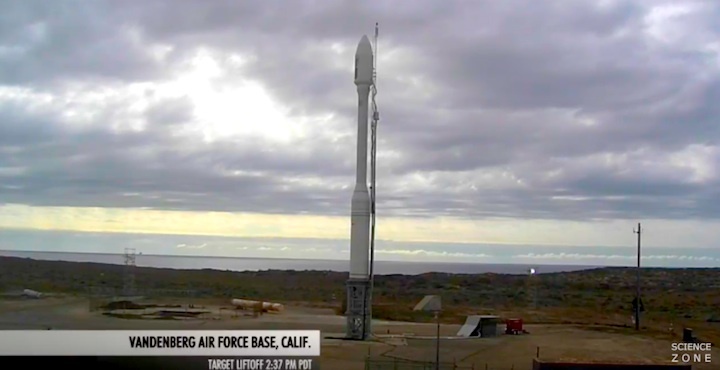
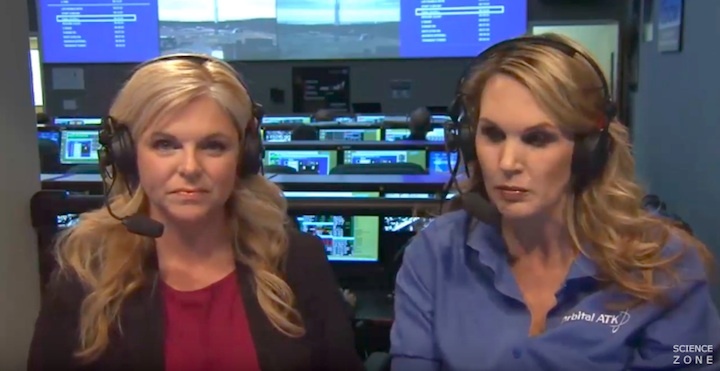
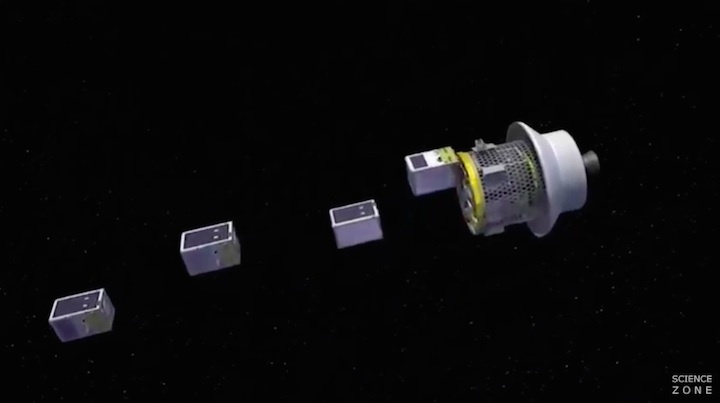
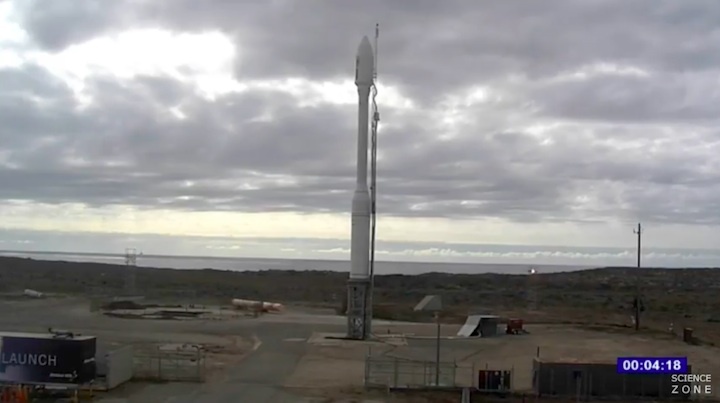
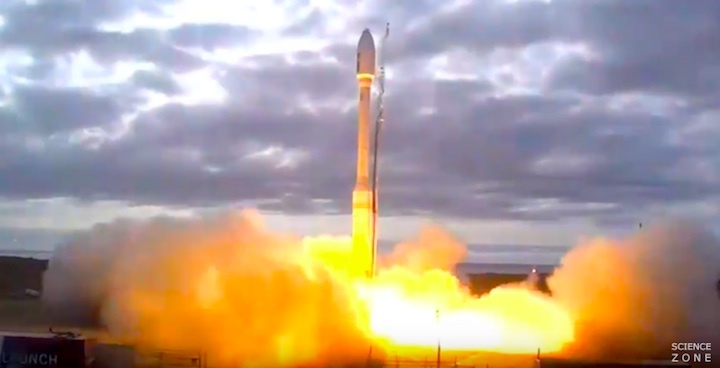
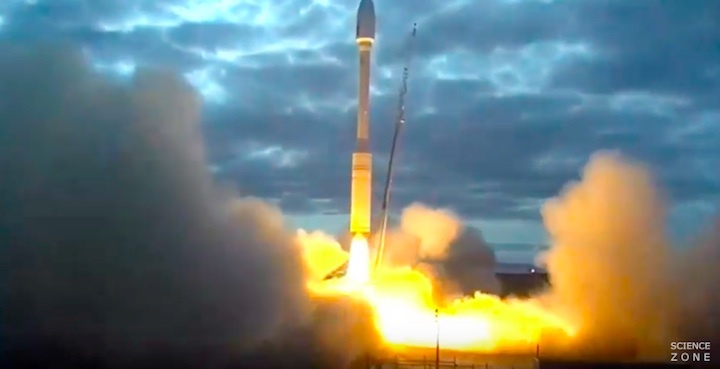

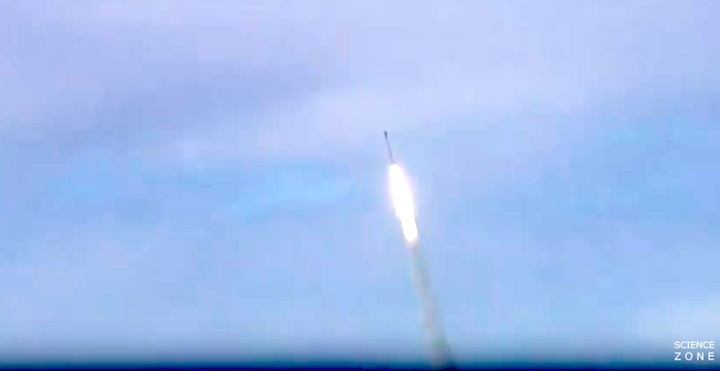
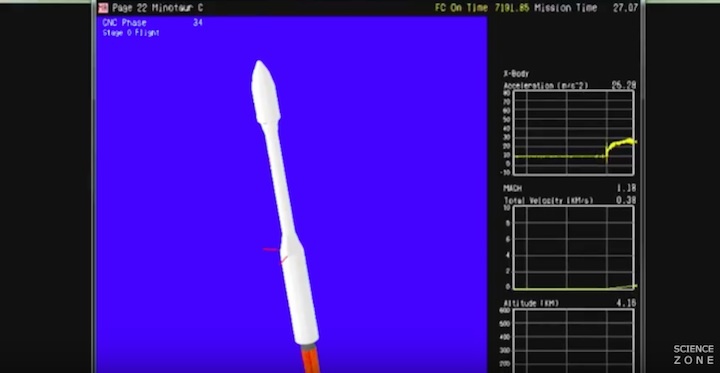
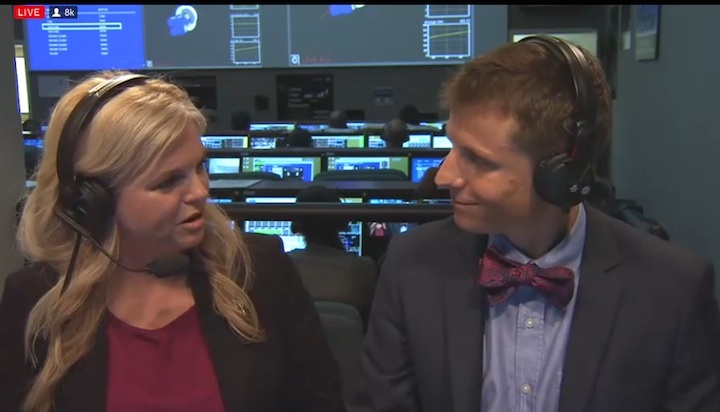
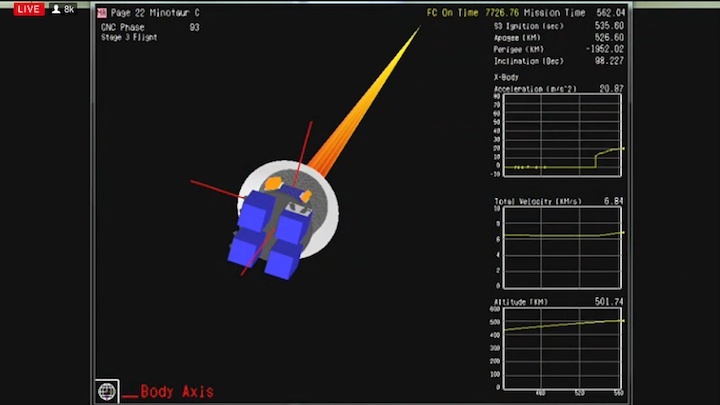
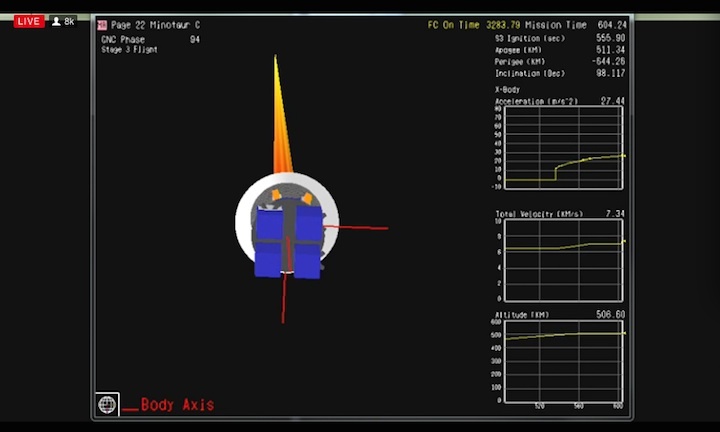
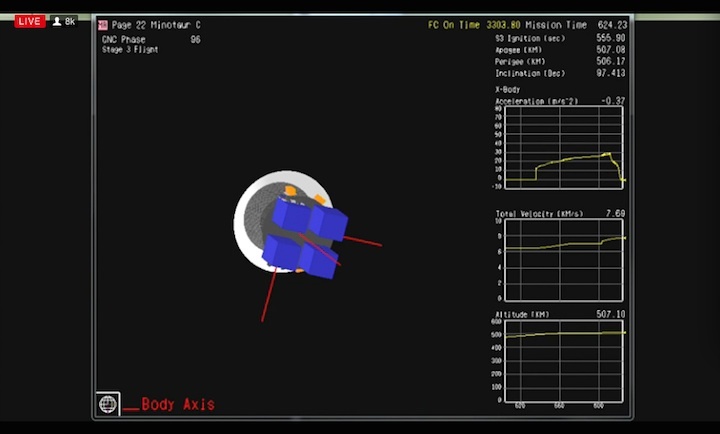
Quelle: orbital ATK
+++
Orbital ATK Minotaur-C launches SkySat mission out of Vandenberg

Orbital ATK’s Taurus-XL rocket – now renamed Minotaur-C – returned to flight on Tuesday with a commercial mission deploying ten satellites for Planet Labs, six and a half years after its last launch ended in failure. Liftoff took place from Vandenberg Air Force Base’s Space Launch Complex 576E (SLC-576E) at 14:37 local time (21:37 UTC).
Minotaur-C Launch:
Tuesday’s launch was the first time that Orbital ATK has flown their Minotaur-C rocket since it was renamed in 2014. Formerly known as Taurus, the rocket last flew in March 2011 when it suffered the second of two consecutive – and near-identical – launch failures.

Minotaur-C is based on Orbital ATK’s air-launched Pegasus rocket, substituting the carrier aircraft for a powerful solid rocket motor to carry the vehicle away from the ground.
Early launches used SR118 solid rocket motors from decommissioned Peacekeeper missiles. However, Orbital later switched to Castor 120 motors in order to open up the rocket up to commercial customers.
Beginning with a March 1994 maiden flight, Minotaur-C made nine launches under the Taurus name: six successful and three failures.
The rocket’s first failure occurred during the sixth launch in September 2001 when control of the vehicle was briefly lost after first stage separation. Although the rocket resumed its planned course after about five seconds, it was unable to place the commercial OrbView-4 imaging satellite into orbit.

The second failure occurred in February 2009, when a Taurus-XL lifted off with NASA’s Orbiting Carbon Observatory (OCO) aboard.
The payload fairing, designed to protect the spacecraft as the rocket ascends through the atmosphere, failed to separate after it was no longer needed. Carrying the additional mass of the fairing for longer than expected, the rocket was too heavy to achieve orbit and reentered over the Antarctic.
After the OCO failure, Orbital conducted an investigation and made changes to the rocket that were expected to ensure that the failure would not happen again on a future launch.
Two years later, Taurus returned to flight with the launch of NASA’s Glory mission but again the fairing failed to separate.

The repeated failure shook confidence in the rocket and led to NASA canceling the planned launch of its OCO-2 satellite – a replacement for the original OCO – and transferring the satellite to United Launch Alliance’s Delta II vehicle instead.
An investigation into the Glory failure was unable to identify what had caused the fairing not to separate. Earlier this year, Portland newspaper The Oregonian reported that NASA was investigating a link with a local company that supplied aluminum components – and who had allegedly falsified testing results to indicate that their components had passed strength tests which they had not.

Since the two launch failures, Orbital has sought to distance itself from the Taurus brand. The Taurus II rocket, then under development alongside the company’s Cygnus spacecraft as part of NASA’s Commercial Orbital Transportation Services (COTS) program, was renamed Antares in late 2011.
In early 2014 Taurus itself was rebranded as Minotaur-C, adopting the name of Orbital’s family of missile-derived rockets used for military satellite and suborbital launches.
The ten satellites aboard the Minotaur-C for Tuesday’s launch will all be operated by Planet Labs.

The primary payload consists of six SkySat high-resolution imaging spacecraft for Planet’s subsidiary Terra Bella – formerly known as Skybox Imaging – which was acquired from technology giant Google in April.
The other four spacecraft are Dove CubeSats, the Flock-3m mission, which will form part of Planet’s large constellation of Earth-observing CubeSats. It is the first dedicated launch for Planet Labs or Terra Bella – as previously both companies have launched their satellites as secondary payloads on other companies launches,
Based in the United States, SkyBox Imaging was formed in 2009 and bought by Google in 2014 at a cost of half a billion dollars. The company’s first prototype satellite, SkySat-1, was launched by a Dnepr rocket in November 2013. A second prototype, SkySat-2, flew in July 2014 aboard a Soyuz-2-1b/Fregat rocket: a secondary payload to the launch of a Russian Meteor-M weather satellite.

The first operational SkySat spacecraft were launched in 2016: SkySat-3 was carried to orbit by India’s PSLV rocket in June, while SkySat-4, 5, 6 and 7 flew aboard a European Vega rocket in September.
Planet Labs announced in February 2017 that it had entered an agreement with Google to acquire Terra Bella, with the purchase being completed on 14 April. As part of the deal, Google bought a stake in Planet Labs and agreed to purchase images back from the company. Tuesday’s launch is the first for Terra Bella since its change of ownership.
The six satellites aboard Tuesday’s launch are SkySat-8, 9, 10, 11, 12 and 13 – which have also been known as SkySat-C6 to C11.
Each SkySat spacecraft has a mass of approximately 120 kilograms (260 lb). The prototype satellites were built by SkyBox themselves, who then licensed the design to Space Systems/Loral and contracted them to produce the operational spacecraft.

The prototypes were slightly smaller than the operational satellites, and are not equipped with propulsion systems. The operational satellites use one-newton (0.22-pounds-force) High-Performance Green Propulsion (HPGP) thrusters developed by ECAPS, a subsidiary of the Swedish Space Corporation.
SkyBox initially ordered thirteen satellites from Space Systems/Loral, in addition to the two prototypes it had built itself. In January 2016, six further satellites were ordered, while Terra Bella holds options that could be exercised to procure further spacecraft.
The imaging system aboard each SkySat consists of a Ritchey-Chretien Cassegrain telescope, which has a focal length of 3.6 meters (11.8 feet). Incoming light is collected by complementary metal-oxide-semiconductor (CMOS) sensors, with half of each satellite’s detector allocated to panchromatic imaging and the other half divided into four bands – near-infrared, red, green and blue – for multispectral imagery.
SkySat can produce panchromatic images at resolutions of up to 86 centimeters (2.8 feet) and multispectral images at resolutions of one meter (3.3 feet). As well as taking still images, the SkySat spacecraft can also record short high-definition videos from orbit.

For Tuesday’s launch, two of the SkySat spacecraft were attached directly to Minotaur-C’s payload adaptor, with the remaining four attached to an “upper bulkhead”, a multi-satellite adaptor allowing two levels of payloads to be carried aboard the rocket. As well as two SkySat satellites, the Flock-3m CubeSats were located underneath this adaptor.
Flock-3m is the latest batch of satellites to be launched for Planet Labs’ constellation of medium-resolution satellites. Each Flock mission consists of a number of three-unit CubeSats, which can image the Earth at resolutions of up to three meters (9.8 feet), depending on their orbit.

By using a large fleet – or flock – of satellites, frequent passes can be made over the same points on the ground. This allows for near-real-time monitoring of changes on the surface and can provide up-to-date images to customers.
Planet Labs itself was founded in December 2010. Originally named Cosmogia Incorporated, the company saw its first prototype satellite – Dove-2 – deployed by a Soyuz-2-1a rocket in April 2013.
Dove-1 was launched two days later aboard the maiden flight of Orbital Sciences Corporation’s Antares rocket. Two further prototypes were launched by a Dnepr in November 2013: one was deployed from the rocket itself and the other was to have been released from another satellite, UniSat-5 but this failed to deploy it.

The first operational Dove satellites, Flock-1, were deployed from the International Space Station following launch as cargo aboard the OA-1 Cygnus mission, carried to orbit by an Antares rocket in January 2014.
Over three hundred Doves have been launched since, using Antares, Atlas V, Dnepr, Falcon 9, H-IIB, PSLV and Soyuz rockets.
Two Flocks were lost in separate launch failures: the twenty-six satellites of Flock-1d were destroyed in the October 2014 Antares launch failure, shortly after the rocket lifted off with the OA-3 Cygnus mission aboard, while the eight-satellite Flock-1f was lost with SpaceX’s CRS-7 Dragon mission when its Falcon 9 rocket failed in June 2015.

Minotaur-C is a four-stage rocket, using solid propellant in all four stages. The numbering of the rocket’s stages reflects its heritage as a ground-launched version of Orbital’s Pegasus: the Castor 120 that will carry it away from the launch pad and into the upper reaches of the stratosphere is designated Stage Zero; the Pegasus stages stacked atop it are stages one, two and three.
The Planet Labs launch used the Minotaur-C’s 3210 configuration. Each digit of this designation indicates a different aspect of the vehicle which is designed to be interchangeable.
The first digit indicates the type of stage zero motor and the configuration of the rocket as a whole. The three indicates that it is a Minotaur-C-XL vehicle (formerly Taurus-XL), with a Castor-120 stage zero and stretched “XL” versions of the first and second stages.

If the value of this digit were a one, it would indicate the “SSLV” configuration – formerly known as the ARPA Taurus – with a Peacekeeper first stage and standard first and second stages. A two would indicate the “standard” Minotaur-C (or “Commercial Taurus”) which also used standard first and second stages but with the Castor-120 stage zero.
The second digit of the rocket’s configuration denotes the type of payload fairing being used. A one indicates the smaller of the vehicle’s two fairings, which has a diameter of 1.6 meters (63 inches), while a two – as in the case of Tuesday’s launch – represents the larger 2.3-metre (92-inch) fairing.
The third and fourth digits are always a one and a zero respectively, indicating that the rocket is using an Orion-38 third stage and no fourth stage. A Star-37FM motor could be used as either a third or a fourth stage – in which case the corresponding digit would be a three – however this has never been flown.
Tuesday’s launch was the second to use the 3210 configuration, which was last used in May 2004 to deploy Taiwan’s ROCSAT-2 satellite – later renamed Formosat-2. The ROCSAT-2 mission was the last successful Taurus launch. Across all Minotaur-C-XL configurations, the SkySat launch is the fourth flight: the failed OCO and Glory launches both used the Taurus-XL 3110 configuration.

Launches of the Minotaur-C take place from Vandenberg Air Force Base in California, making use of Space Launch Complex 576E (SLC-576E).
Originally built as an Atlas missile silo as part of the 576th Strategic Missile Squadron’s test complex at Vandenberg, along with two other silos, five hardened “coffin” launchers and three surface launch pads, 576E was used for four launches of Atlas-F missiles between August 1962 and December 1964.
After this, the complex would not see another launch until Taurus made its maiden flight in 1994. In addition to the nine Taurus launches to date, the complex was also used for the suborbital “Taurus-Lite” launch in February 2003, which tested another ground-launched version of Pegasus – without an additional stage to boost it – that would be used to support the Ground Based Interceptor (GBI) missile defense system.
Tuesday’s launch began with ignition of the Castor 120 motor, at the zero mark in the countdown. This stage burned for 85.5 seconds before burning out and separating. What is designated the first stage – an Orion-50XLST motor – then ignited to power the rocket out of the atmosphere.

The Orion-50XLST is the same motor that Pegasus-XL rocket uses as its first stage, but when flown on Taurus or Minotaur-C, it is not fitted with the wings or tail planes that the Pegasus requires for its horizontal launch profile. Its burn lasted 78.7 seconds, with the spent stage being jettisoned 5.1 seconds after burnout. Stage two – an Orion-50XLT motor – ignited 2.2 seconds after separation.
Seven and a half seconds after stage two ignited, Tuesday’s mission reached the point at which Taurus’ two most recent launches both failed. The payload fairing, which protects the satellite from damage as the rocket passes through the atmosphere, was jettisoned from the nose of the vehicle. This occurred successfully.
This event was critical, not just because the payloads will not be able to separate cleanly with the fairing still attached, but also because its additional weight would prevent Minotaur-C reaching its planned orbit if it was not discarded successfully.
At the point of fairing separation, Minotaur-C was at 356 kilometers (221 miles, 192 nautical miles) downrange, at an altitude of 160 kilometers (99 miles, 86 nautical miles) and traveling at a velocity of 4.27 kilometers per second (9,550 mph). Tuesday’s mission was using a different payload fairing to the OCO and Glory launches – the larger 2.3 meter (92-inch) fairing instead of the 1.6-metre (63-inch) fairing used on the failed launches.
The second stage burned for 77.9 seconds. After it burns out, the mission entered a coast phase as the rocket ascended towards the apogee of its trajectory. Sixty-four seconds after burnout the second stage was jettisoned, with the Orion-38 third stage igniting after another four minutes and 2.6 seconds of coasting. The third stage burned for 71.2 seconds.
Two minutes after the third stage burned out – thirteen minutes and 22.2 seconds after lifting off – the first SkySat spacecraft separated from the top of the upper bulkhead payload adaptor. The other three satellites attached to this adaptor separated at twenty-second intervals. The upper bulkhead itself was jettisoned one minute after the fourth SkySat separates.

Spacecraft separation events resumed 80.5 seconds after the upper bulkhead was released, with the fifth SkySat being released and the sixth following twenty seconds later. This concluded separation of the primary payloads.
The first two Flock-3m satellites were deployed seventy seconds after the last SkySat, with the remaining two being released 24.5 seconds afterwards. With all payloads separated, Minotaur-C’s upper stage was secured, and the mission concluded 21 minutes and 25.9 seconds after liftoff.
The planned orbit at spacecraft separation will be a circular sun-synchronous orbit at an altitude of 500 kilometers (310 miles, 270 nautical miles).
Tuesday’s launch was currently the only Minotaur-C mission on Orbital ATK’s books. Orbital ATK has given no indication that it plans to retire the Minotaur-C, so the rocket will likely remain available should its services be called upon in the future. That said, if future launches do not emerge, Tuesday’s could be the rocket’s final flight.
Orbital’s next launch is scheduled for 11 November, with an Antares rocket flying out of Virginia’s Mid-Atlantic Regional Spaceport (MARS) on Wallops Island with the OA-8 Cygnus mission bound for the International Space Station. Another launch, scheduled for 8 December, will see the air-launched Pegasus-XL rocket deploy NASA’s Ionospheric Connection Explorer (ICON) satellite from Kwajalein Atoll in the Marshall Islands.
Quelle: NS

